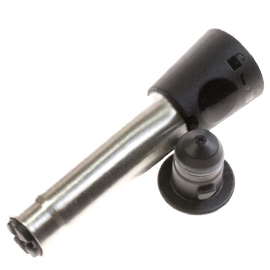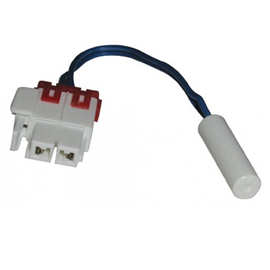Your Espresso Machine’s Steam Wand Is Not Working

Is your espresso coffee machine no longer producing steam? Here we help you understand what might be causing this fault with your appliance, and detail the steps you need to take to fix it.
THE POSSIBLE CAUSES FOR THIS FAULT :
-
The steam wand is clogged
-
The control switch is broken
-
The temperature sensor is defective
-
The heating element is broken
-
The solenoid valve is blocked
WARNING
Before you do anything to your appliance, make sure you disconnect it from the power supply.
There is a risk of electric shock.
The steam wand is clogged
 By directing steam into your cup or mug, the steam wand enables you to make great cappuccinos. If it's blocked, it will no longer be able to produce a jet of steam. You can clean this component using a needle and by leaving it to soak in a glass of white vinegar. To ensure the steam wand remains clean, switch its button to steam position for a few seconds after each use. This gets rid of any residual milk left over after you've made your cappuccino.
By directing steam into your cup or mug, the steam wand enables you to make great cappuccinos. If it's blocked, it will no longer be able to produce a jet of steam. You can clean this component using a needle and by leaving it to soak in a glass of white vinegar. To ensure the steam wand remains clean, switch its button to steam position for a few seconds after each use. This gets rid of any residual milk left over after you've made your cappuccino.
The temperature control thermostat is faulty
 The temperature control thermostat cuts off the water once it's reached the right temperature. If the thermostat is faulty, the water will not reach the 115°C required for steam production. The wand will then produce hot water but no steam. If the temperature control thermostat turns out to be defective, it will need to be replaced.
The temperature control thermostat cuts off the water once it's reached the right temperature. If the thermostat is faulty, the water will not reach the 115°C required for steam production. The wand will then produce hot water but no steam. If the temperature control thermostat turns out to be defective, it will need to be replaced.
The temperature sensor is defective
 Some coffee machines are fitted with a temperature sensor. This sensor serves both to regulate the water temperature and signal to the main circuit board (PCB) that the correct temperature has been reached. If the sensor is defective, warm water rather than steam will emerge from the steam wand as it will not have been able to reach the 115°C required for steam production. If the temperature sensor is defective, you will need to replace it.
Some coffee machines are fitted with a temperature sensor. This sensor serves both to regulate the water temperature and signal to the main circuit board (PCB) that the correct temperature has been reached. If the sensor is defective, warm water rather than steam will emerge from the steam wand as it will not have been able to reach the 115°C required for steam production. If the temperature sensor is defective, you will need to replace it.
The heating element is broken
 The heating element both heats the water and keeps it hot while it's stored in the machine waiting to be dispensed. If your water is high in calcium, the heating element, by heating it up, will speed up the build-up of limescale inside your espresso coffee machine. Eventually, it will become blocked. To avoid this happening, we recommend regularly descaling your appliance. If the heating element is broken, however, it will unfortunately need to be replaced.
The heating element both heats the water and keeps it hot while it's stored in the machine waiting to be dispensed. If your water is high in calcium, the heating element, by heating it up, will speed up the build-up of limescale inside your espresso coffee machine. Eventually, it will become blocked. To avoid this happening, we recommend regularly descaling your appliance. If the heating element is broken, however, it will unfortunately need to be replaced.
The solenoid valve is blocked
 The solenoid is an electric valve that controls whether or not the water flows or the steam is released. If it gets blocked or it's defective, the steam will only be released very slowly, or not at all. Before proceeding to replace it, however, try cleaning it first by descaling the water and steam circulation system. Then test it again.
The solenoid is an electric valve that controls whether or not the water flows or the steam is released. If it gets blocked or it's defective, the steam will only be released very slowly, or not at all. Before proceeding to replace it, however, try cleaning it first by descaling the water and steam circulation system. Then test it again.
